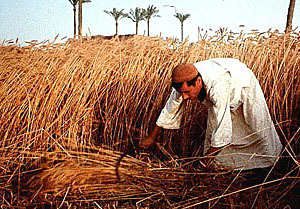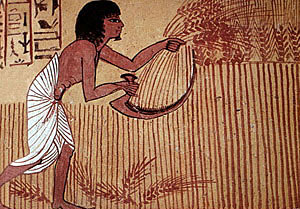The techniques for gathering or harvesting cereal crops, shown above left in a tomb painting of New Kingdom Egypt and below right in photograph of a modern Egyptian farmer, remind us how precious a commodity grain was to early civilizations. Grain was dearly bought with human sweat and diligence and strict social organization. Most cultures quite naturally came to associate the main crops that sustained their existence with the substance of life itself, either worshipping those plants or seeing them as symbols of the power of life.
 The precariousness of hard-won wealth in grain is difficult for many modern people to understand. We are separated from the material base of our culture by the complex nature of our way of life and so cannot see it easily. But for the ancients (as for most developing nations today), both the source of the community's livelihood and the slim margin between life and death were quite visible.
The precariousness of hard-won wealth in grain is difficult for many modern people to understand. We are separated from the material base of our culture by the complex nature of our way of life and so cannot see it easily. But for the ancients (as for most developing nations today), both the source of the community's livelihood and the slim margin between life and death were quite visible.
There is only a short period of time each year in harvest season in which to reap the grain; wet weather at the wrong time can spoil the crop; social disorder at planting or harvest time may mean famine. In addition, once harvested, the grain must be stored and protected against dampness, against vermin such as rats and mice, insects, mold and fungi. And if that were not problem enough, stored grain easily becomes stolen grain, so it must always be protected against thieves and enemy raiders. In this way, wealth brought with it "security problems" which had not existed before.
 The precariousness of hard-won wealth in grain is difficult for many modern people to understand. We are separated from the material base of our culture by the complex nature of our way of life and so cannot see it easily. But for the ancients (as for most developing nations today), both the source of the community's livelihood and the slim margin between life and death were quite visible.
The precariousness of hard-won wealth in grain is difficult for many modern people to understand. We are separated from the material base of our culture by the complex nature of our way of life and so cannot see it easily. But for the ancients (as for most developing nations today), both the source of the community's livelihood and the slim margin between life and death were quite visible. The techniques for gathering or harvesting cereal crops, shown above left in a tomb painting of New Kingdom Egypt and below right in photograph of a modern Egyptian farmer, remind us how precious a commodity grain was to early civilizations. Grain was dearly bought with human sweat and diligence and strict social organization. Most cultures quite naturally came to associate the main crops that sustained their existence with the substance of life itself, either worshipping those plants or seeing them as symbols of the power of life.
The techniques for gathering or harvesting cereal crops, shown above left in a tomb painting of New Kingdom Egypt and below right in photograph of a modern Egyptian farmer, remind us how precious a commodity grain was to early civilizations. Grain was dearly bought with human sweat and diligence and strict social organization. Most cultures quite naturally came to associate the main crops that sustained their existence with the substance of life itself, either worshipping those plants or seeing them as symbols of the power of life.